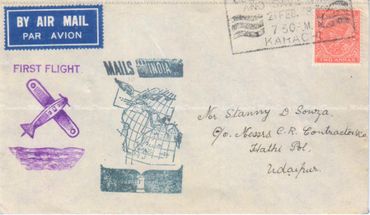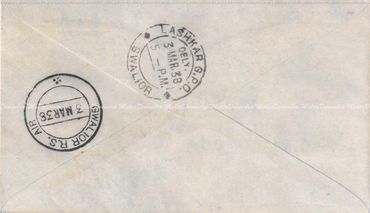The 1938 Coogee Flights
The Story
In the 1920s, Imperial Airways was weaving an intricate web of airmail and passenger routes across the British Empire. However, the journey from Britain to Karachi was a convoluted seven-day odyssey; a dizzying mix of planes and trains: by plane from Croydon to Basle, followed by train to Genoa, thereafter, plane to Alexandria, aboard train once more to Cairo, and the final leg by plane to Karachi.
Thus, there was a search for an efficient route to speed up mail communication and passenger services within the territories of British Empire. It was estimated that four to five flights per week to India were required to achieve the objective. The launch of a subsidised scheme by the British Government, i.e., Empire Air Mail Scheme, in 1934, acted as an impetus.
However, the British Government and the Imperial Airways did not have the requisite funds, to keep land aerodromes in serviceable condition, throughout the year, amidst varying climatic conditions and topography of the vast empire. Thus, it was decided to use sea planes.
Enter the flying boats, the majestic "Short S.23C Class" seaplanes, each christened with names beginning with "C." Short Brothers of Rochester were roped in to manufacture the boats. The flying boat on the inaugural trip to India was called Coogee, entered into British Aircraft Register as G-AEUG, which later flew under Qantas as VH-ABC.
On February 17, 1938, Captain Alger guided the Coogee on a historic voyage across uncharted skies, to explore an alternate route across India, touching down on forgotten lakes that rarely feature in aviation lore. This wasn’t just a flight, it was an expedition with a sense of adventure and awe.
Step aboard, the flying boat and one would find luxuries fit for royalty: plush seating, gourmet meals, smoking rooms, leather recliners, stowable dining tables, and open decks for sky-high sundowners amidst breathtaking landscapes. The journey was as much about the spectacle as it was about speed. The flying experience chronicled in the diaries of the passengers was published in the Imperial Airways Gazette of those years.
The journey began in Southampton, where the great flying boats, gleaming behemoths of the sky, lifted off into the dawn, bound for the far corners of the Empire. The first stop: Marseilles, where the Mediterranean shimmered beneath their hulls. By the second day, they were alighting on Lake Bracciano, a volcanic jewel northwest of Rome, its shining waters reflecting the Italian sun. The lake was originally known as Lake Sabatine, named after the adjacent Sabatine Mountains.
Day three unfolded like a traveller’s dream, a sweeping, sun-drenched arc over Brindisi, Athens, and Crete, where the flying boat descended towards north-east of Crete onto the secluded landlocked Lake Mirabella, its emerald waters cradled by rugged Cretan cliffs. Refuelled and restless, the flying boat carved through mountain passes before braving 400 miles of open sea, arriving by dusk at Alexandria, where the cosmopolitan buzz of Egypt awaited.
The fourth day brought a dramatic descent over the Nile Delta, skirting south of Haifa, near the town of Tiberias before touching down on the Sea of Galilee, its surface lying mysteriously below sea level. Then after refuelling and restocking supplies a long flight over the desert. For 470 miles, the flying boat raced above an endless ochre expanse, guided only by the thin, glinting thread of an oil pipeline snaking from Haifa to Iraq. The Euphrates emerged like a mirage, leading them to Lake Habbaniyeh, a shimmering oasis 90kms west of Baghdad, where the RAF base provided fuel and supplies. Scorching through the endless desert the flying boat flew over two full rivers, Euphrates and Tigris and the marshland formed by the two, to land at Basra for the night having conquered 1,150 miles in a single day.
After a pre-dawn take-off amidst dramatic flares lighting up the sky, dawn on the fifth day broke over the Persian Gulf, where the flying boat skimmed above pearl divers’ dhows, their sails like scattered petals on the water. Bahrain, Dubai, Baluchistan, Oman and Gwadar, gave a fleeting glimpse of Arabia’s coastal mystique, before finally banking toward Karachi harbour, the Gateway to India for the night.
From Karachi the journey was to take an unusual path to Calcutta. Unlike the usual land-based hops to Calcutta (Karachi–Jodhpur–Delhi–Allahabad), this route embraced India’s hidden waterways and lakes.
On the sixth day, the flying boat surged over the Thar Desert, its dunes rolling like frozen waves, continuing over the hilly, wooded and green state of Udaipur before descending onto Rajsamand Lake in Kankroli, 67 km from Udaipur. Built in the 17th century by Maharana Raj Singh, the lake is surrounded by rolling hills and white marble embankments bearing inscriptions that echo tales of valour, devotion, and royal legacy. The waters of the lake were used for irrigation and drinking and thus special care was taken not to dump anything in the lake. The Maharana of Udaipur was instrumental in getting the requisite infrastructure: a meteorological station, a passenger lounge, fuel depots, even a royal bungalow stood ready, and every letter dispatched on that sea plane bore the “Kankroli Air” postmark.
Next, Gwalior. The flying boat traced the silhouette of the imposing and majestic fort which housed The Scindia School. A powerful light high up on the Fort signalled the letter “G” for guidance to flying boats. The Madhosagar lake where the boat descended amidst kingfishers and lotuses was eleven miles south-west of Lashkar and a hive of activity; Burmah Shell fuellers, wireless operators, and passengers sipping chai. The mail emanating from Gwalior was postmarked either Gwalior or Gwalior R.S. Air.
Then, the holy waters of Allahabad, where the Yamuna and Ganges converged, and lunch was served beside India’s most sacred confluence. The final leg swept over palms and emerald paddies before the Hooghly River cradled the flying boat at Calcutta, where the Great Eastern Hotel, a luxurious and opulent palace awaited. Next morning the boat would take off to Singapore, via Akyab, Rangoon, Bangkok and Penang.
This was no ordinary voyage. Imperial Airways spared no expense. Each night was spent in a five-star sanctuary, the most luxurious of hotels; Grand Hotel de Russie at Rome, Hotel Ceicl at Alexandria, and Raffles at Singapore; luxurious houseboats and hotels were also available at all the refuelling stations. Gourmet feasts on the house; five-course luncheons, vintage wines, and fresh local delicacies at every stop.
A version of this story was published by Outlook Traveller

Eastward - Karachi to Gwalior (The envelope inadvertently went to Gwalior instead of being downloaded at Kankroli; returned thereafter


Eastward - Kankroli to Calcutta


Eastward - Kankroli to Calcutta


Eastward - Gwalior to Allahabad


Eastward - Gwalior to Allahabad by Coogee and thereafter to Cawnpore


Westward - Calcutta to Gwalior


Westward - Calcutta to Gwalior


Westward - Gwalior to Kankroli


Westward - Gwalior to Karachi


Westward - Gwalior to Karachi


Westward - Gwalior to Southampton

